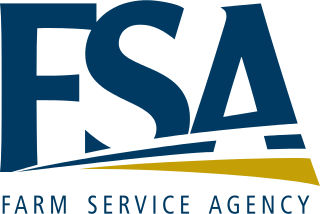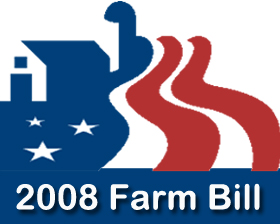Related Research Articles

The Farm Service Agency (FSA) is the United States Department of Agriculture agency that was formed by merging the farm loan portfolio and staff of the Farmers Home Administration (FmHA) and the Agricultural Stabilization and Conservation Service (ASCS). The Farm Service Agency implements agricultural policy, administers credit and loan programs, and manages conservation, commodity, disaster and farm marketing programs through a national network of offices. The Administrator of FSA reports to the Under Secretary of Agriculture for Farm Production and Conservation. The current Administrator is Richard Fordyce. The FSA of each state is led by a politically appointed State Executive Director (SED).

The 1965 Canadian federal election was held on November 8 to elect members of the House of Commons of Canada of the 27th Parliament of Canada. The Liberal Party of Prime Minister Lester B. Pearson was re-elected with a larger number of seats in the House. Although the Liberals lost a small share of the popular vote, they were able to win more seats, but fell just short of having a majority.
Crop insurance is purchased by agricultural producers, and subsidized by the federal government, to protect against either the loss of their crops due to natural disasters, such as hail, drought, and floods, or the loss of revenue due to declines in the prices of agricultural commodities. The two general categories of crop insurance are called crop-yield insurance and crop-revenue insurance. On average, the federal government subsidizes 62 percent of the premium. In 2019, crop insurance policies covered almost 380 million acres. Major crops are insurable in most counties where they are grown, and approximately 90% of U.S. crop acreage is insured under the federal crop insurance program. Four crops—corn, cotton, soybeans, and wheat— typically account for more than 70% of total enrolled acres. For these major crops, a large share of plantings is covered by crop insurance.

In the United States, the farm bill is the primary agricultural and food policy tool of the federal government. Every five years, Congress deals with the renewal and revision of the comprehensive omnibus bill.
The agricultural policy of the United States is composed primarily of the periodically renewed federal U.S. farm bills. The Farm Bills have a rich history which initially sought to provide income and price support to US farmers and prevent them from adverse global as well as local supply and demand shocks. This implied an elaborate subsidy program which supports domestic production by either direct payments or through price support measures. The former incentivizes farmers to grow certain crops which are eligible for such payments through environmentally conscientious practices of farming. The latter protects farmers from vagaries of price fluctuations by ensuring a minimum price and fulfilling their shortfalls in revenue upon a fall in price. Lately, there are other measures through which the government encourages crop insurance and pays part of the premium for such insurance against various unanticipated outcomes in agriculture.

The Federal Crop Insurance Corporation (FCIC) is a wholly owned government corporation managed by the Risk Management Agency of the United States Department of Agriculture. FCIC manages the federal crop insurance program, which provides U.S. farmers and agricultural entities with crop insurance protection.
The Agricultural Market Transition Act (AMTA) — Title I of the 1996 farm bill — allowed farmers who had participated in the wheat, feed grain, cotton, and rice programs in any one of the 5 years prior to 1996 to enter into 7-year production flexibility contracts for 1996-2002. Total national production flexibility contract payments for each fiscal year were fixed in the law. The AMTA allowed farmers to plant 100% of their total contract acreage to any crop except fruits and vegetables, and receive a full payment. Land had to be maintained in agricultural uses. Unlimited haying and grazing and planting and harvesting alfalfa and other forage crops was permitted with no reduction in payments. AMTA commodity support provisions were replaced by the 2002 farm bill, a 6-year farm bill.

The Agriculture Risk Protection Act of 2000 made major revisions to the United States' federal crop insurance program and provided emergency agricultural assistance. The crop insurance provisions significantly increased the program's government subsidy; improved coverage for farmers affected by multiple years of natural disasters; and authorized pilot insurance programs for livestock farmers and growers of other farm commodities that were not served by crop insurance, among many other provisions. The emergency provisions made available a total of $7.14 billion in emergency farm assistance, mostly in direct payments to growers of various commodities to compensate for low farm commodity prices.
Catastrophic crop insurance (CAT) is a component of the U.S. federal crop insurance program, originally authorized by the Federal Crop Insurance Reform Act of 1994. CAT coverage compensates farmers for crop yield losses exceeding 50% of their average historical yield at a payment rate of 55% of the projected season average market price. CAT coverage requires that a farmer realize a yield loss of more than 50% and only makes payments on losses exceeding the 50% threshold. Producers pay no premium for CAT coverage, but except for cases of financial hardship must pay an administrative fee of $300 per crop. A producer has the ability to purchase additional insurance coverage beyond CAT coverage, but must pay a premium, partially subsidized by the government.

The Food, Agriculture, Conservation, and Trade (FACT) Act of 1990 — P.L. 101-624 was a 5-year omnibus farm bill that passed Congress and was signed into law.
In the United States, deficiency payments are direct government payments made to farmers who participated in annual commodity programs for wheat, feed grains, rice, or cotton, prior to 1996.

The Federal Crop Insurance Reform and Department of Agriculture Reorganization Act of 1994, Pub.L. 103–354, 108 Stat. 3178, was introduced on April 14, 1994 by Eligio de la Garza (D-TX) and was signed into law on October 13, 1994 by President William J. Clinton. It consisted of two titles:
In United States agricultural policy, disaster payments are direct federal payments provided to crop producers when either planting is prevented or crop yields are abnormally low because of adverse weather and related conditions. Between 1988 and 2005, ad hoc disaster legislation was enacted for each crop year, providing a total of nearly $20 billion in direct disaster payments to farmers. These payments were made both to producers with crop insurance and those without insurance.
In United States agricultural policy, the triple base plan, also called the flexible base plan, is a proposal under which farmers who raise program crops would receive program payments only on a certain percentage of their permitted acreage. A producer participating in a federal price support program actually would have three categories of base acres for program purposes:
The Direct and Counter-cyclical Payment Program (DCP) of the USDA provides payments to eligible producers on farms enrolled for the 2002 through 2007 crop years. There are two types of DCP payments – direct payments and counter-cyclical payments. Both are computed using the base acres and payment yields established for the farm. DCP was authorized by the 2002 Farm Bill and is administered by the Farm Service Agency (FSA).
Multi-Peril Crop Insurance (MPCI) is the oldest and most common form of the federal crop insurance programme in the United States of America. MPCI protects against crop yield losses by allowing participating producers to insure a certain percentage of historical crop production. A single policy protects crops against all natural perils including adverse weather, fire, insects, disease, wildlife, earthquake, volcanic eruption and failure of irrigation water due to unavoidable causes. It is delivered by private companies and reinsured by the federal government.
In Canadian agricultural policy, a Gross Revenue Insurance Plan (GRIP) is a form of direct payment combining a crop insurance component and a revenue protection component. Farmers finance one-third of the premiums paid out under the revenue protection component. The GRIP makes payments when market revenue falls short of a producer’s target revenue. Target revenue per acre for an individual crop is based on historical yields, a multi-year moving average of price, and a level of insurance coverage chosen by the producer.
Farm programs can be part of a concentrated effort to boost a country’s agricultural productivity in general or in specific sectors where they may have a comparative advantage. There are many different types of farm programs, with a variety of objectives and created with different economic mechanisms in mind. Some are meant to benefit farmers directly, while others seek to benefit consumers. They target food prices and quantity of food available on the market, as well as production and consumption of certain goods. Some are meant to benefit farmers directly, while others seek to benefit consumers. They target food prices and quantity of food available on the market, as well as production and consumption of certain goods.
The Pradhan Mantri Fasal Bima Yojana (PMFBY) launched on 18 February 2016 by Prime Minister Narendra Modi is an insurance service for farmers for their yields. It was formulated in line with One Nation–One Scheme theme by replacing earlier two schemes National Agricultural Insurance Scheme (NAIS) and Modified National Agricultural Insurance Scheme (MNAIS) by incorporating their best features and removing their inherent drawbacks (shortcomings). It aims to reduce the premium burden on farmers and ensure early settlement of crop assurance claim for the full insured sum.
Index-based insurance, also known as index-linked insurance or, simply, index insurance, is primarily used in agriculture. Because of the high cost of assessing losses, traditional insurance based on paying indemnities for actual losses incurred is usually not viable, particularly for smallholders in developing countries. With index-based insurance, payouts are related to an “index” that is closely correlated to agricultural production losses, such as one based on rainfall, yield or vegetation levels. Payouts are made when the index exceeds a certain threshold, often referred to as a “trigger”. Index-based insurance is not therefore designed to protect farmers against every peril, but only where there is a widespread risk that significantly influences a farmer’s livelihood. Many such indices now make use of satellite imagery.
References
![]() This article incorporates public domain material from the Congressional Research Service document: Jasper Womach. "Report for Congress: Agriculture: A Glossary of Terms, Programs, and Laws, 2005 Edition" (PDF).
This article incorporates public domain material from the Congressional Research Service document: Jasper Womach. "Report for Congress: Agriculture: A Glossary of Terms, Programs, and Laws, 2005 Edition" (PDF).